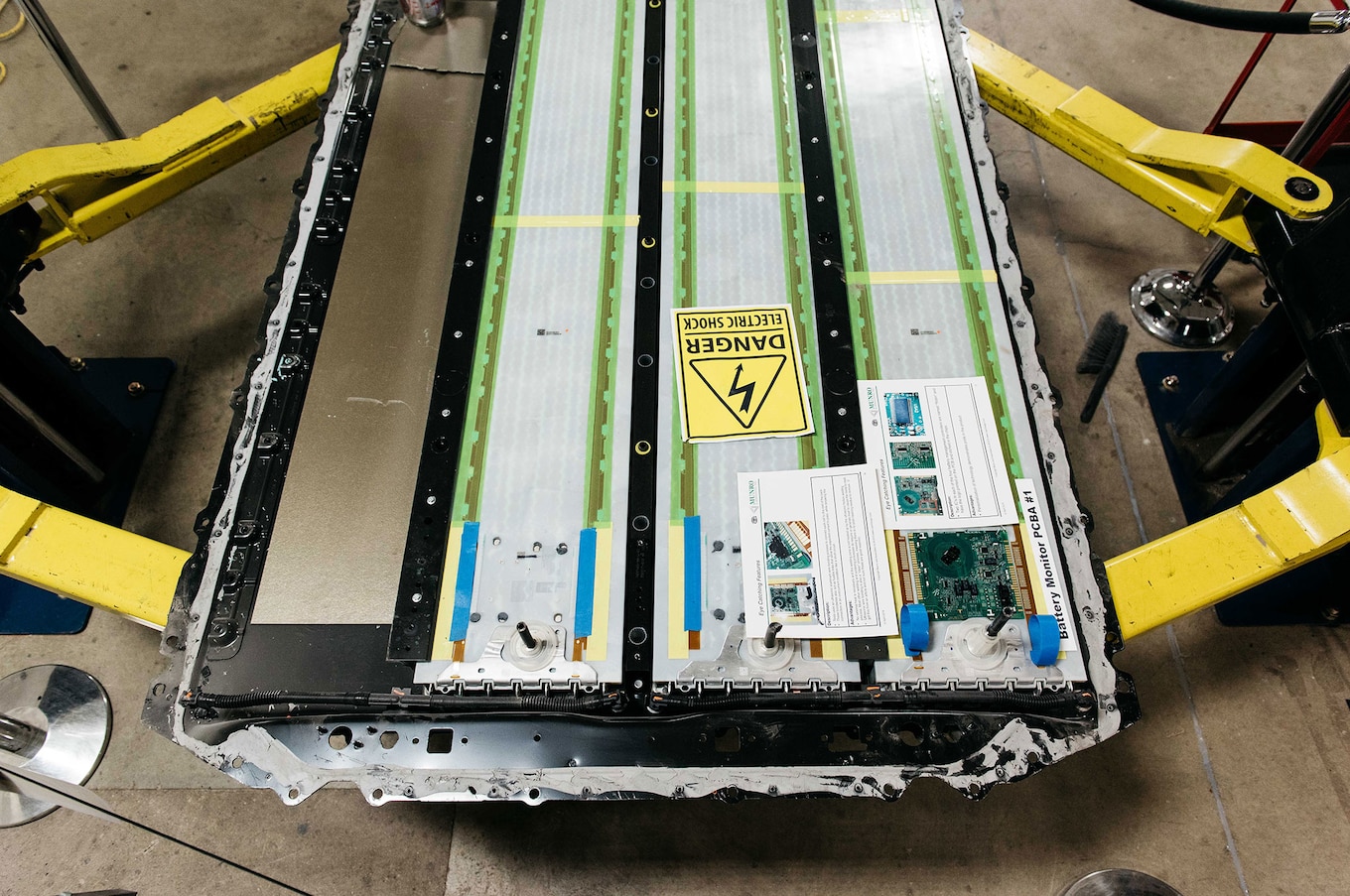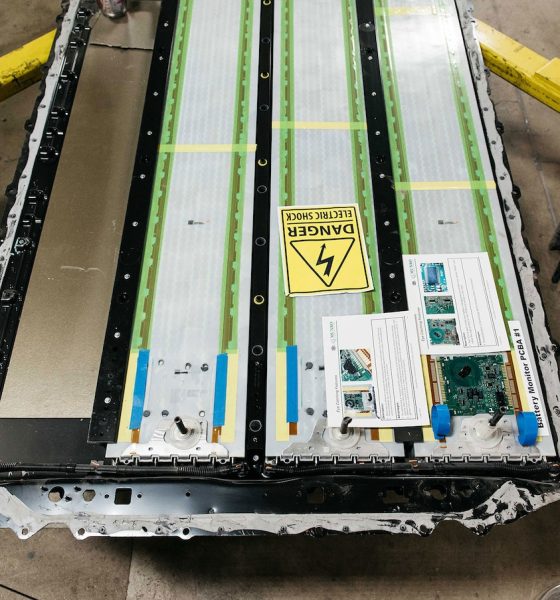

News
Tesla patent paves way for compact battery systems that are easier to produce
Tesla’s use of batteries for its electric vehicles are crucial to their function. The company’s battery systems are the industry standard as they offer more range and density than their competitors. But despite this lead, a recently submitted patent for an aggregated battery system could put Tesla’s batteries head-and-shoulders above the rest of the pack, bar none.
While Tesla’s current battery system is top of the line, it could still be more cost-effective. Batteries themselves cost a lot to manufacture for Tesla, and not to mention, a lot to replace for an owner. The aim of the company’s newly submitted patent is to create a more efficient system that would simplify the entire battery component by combining the multiple battery systems into one single module.
Small battery cells are more advantageous than large battery cells for a number of reasons, including time, safety, thermal management and production of energy. All of these factors would highlight the advantages of small battery systems and would allow for an increase in the productivity of battery cells. The smaller cells means “a shorter length of electrode material that is devoid of material defects would be required.”

The new system would arrange the battery cells in an upright manner. The multiple cells would then function with one another by being connected to a series of collector plates with tabs on both the positive and negative ends of the battery. The tabs would then be connected to a positive or negative terminal of the battery cell. This would be done with multiple series of batteries that all have different responsibilities throughout the vehicle. They would all, however, be housed within a single battery container, allowing engineers or service workers easy access to each battery system.
The addition of this new patent could help reduce costs by utilizing smaller battery cells in battery systems. The patent states that while production will increase due to the reduced size and need for materials, the small cells can increase the complexity of the manufacturing of the systems. This makes Tesla’s batteries even easier to produce.
“For instance, with use of many small format cells, it is envisioned that several electrical interconnects could be required to accomplish the conveyance of current from the large number of small format cells and this may also contribute to the complexity in design and manufacture of the battery system. The battery cell could also have some functionalities that may be redundant when aggregated into the battery system. As each battery cell would be manufactured independently of others, time and resources would need to be spent thereafter for combining the cells and for forming the interconnects to the current collectors typically, though a welding, or soldering process. Hence, there is a need to produce battery modules in a simplified manner.”
The innovations offered by Tesla’s recently published patent could allow the electric car maker to equip its vehicles with battery packs that are both compact and high-density. This would be pivotal to upcoming vehicles such as the next-generation Roadster, the Tesla Pickup Truck, and the Tesla Semi, all of which are expected to require large batteries to achieve their target range, and thus would require large numbers of cells from the electric car maker.
Tesla is the head of the pack in terms of batteries, as the company’s vehicles have considerably longer ranges than the vehicle’s of its competitors. For example, a Tesla Model S Performance variant contains a 100 kWh battery, with a WLTP estimated 365 miles of range when charged to its capacity. The newly released Porsche Taycan Turbo S contains a 93.4 kWh battery with a WLTP estimated 256 miles of range on a full charge.
The full text of Tesla’s novel battery design patent could be accessed here.

News
Tesla FSD fleet is nearing 7 billion total miles, including 2.5 billion city miles
As can be seen on Tesla’s official FSD webpage, vehicles equipped with the system have now navigated over 6.99 billion miles.

Tesla’s Full Self-Driving (Supervised) fleet is closing in on almost 7 billion total miles driven, as per data posted by the company on its official FSD webpage.
These figures hint at the massive scale of data fueling Tesla’s rapid FSD improvements, which have been quite notable as of late.
FSD mileage milestones
As can be seen on Tesla’s official FSD webpage, vehicles equipped with the system have now navigated over 6.99 billion miles. Tesla owner and avid FSD tester Whole Mars Catalog also shared a screenshot indicating that from the nearly 7 billion miles traveled by the FSD fleet, more than 2.5 billion miles were driven inside cities.
City miles are particularly valuable for complex urban scenarios like unprotected turns, pedestrian interactions, and traffic lights. This is also the difference-maker for FSD, as only complex solutions, such as Waymo’s self-driving taxis, operate similarly on inner-city streets. And even then, incidents such as the San Francisco blackouts have proven challenging for sensor-rich vehicles like Waymos.
Tesla’s data edge
Tesla has a number of advantages in the autonomous vehicle sector, one of which is the size of its fleet and the number of vehicles training FSD on real-world roads. Tesla’s nearly 7 billion FSD miles then allow the company to roll out updates that make its vehicles behave like they are being driven by experienced drivers, even if they are operating on their own.
So notable are Tesla’s improvements to FSD that NVIDIA Director of Robotics Jim Fan, after experiencing FSD v14, noted that the system is the first AI that passes what he described as a “Physical Turing Test.”
“Despite knowing exactly how robot learning works, I still find it magical watching the steering wheel turn by itself. First it feels surreal, next it becomes routine. Then, like the smartphone, taking it away actively hurts. This is how humanity gets rewired and glued to god-like technologies,” Fan wrote in a post on X.
News
Tesla starts showing how FSD will change lives in Europe
Local officials tested the system on narrow country roads and were impressed by FSD’s smooth, human-like driving, with some calling the service a game-changer for everyday life in areas that are far from urban centers.

Tesla has launched Europe’s first public shuttle service using Full Self-Driving (Supervised) in the rural Eifelkreis Bitburg-Prüm region of Germany, demonstrating how the technology can restore independence and mobility for people who struggle with limited transport options.
Local officials tested the system on narrow country roads and were impressed by FSD’s smooth, human-like driving, with some calling the service a game-changer for everyday life in areas that are far from urban centers.
Officials see real impact on rural residents
Arzfeld Mayor Johannes Kuhl and District Administrator Andreas Kruppert personally tested the Tesla shuttle service. This allowed them to see just how well FSD navigated winding lanes and rural roads confidently. Kruppert said, “Autonomous driving sounds like science fiction to many, but we simply see here that it works totally well in rural regions too.” Kuhl, for his part, also noted that FSD “feels like a very experienced driver.”
The pilot complements the area’s “Citizen Bus” program, which provides on-demand rides for elderly residents who can no longer drive themselves. Tesla Europe shared a video of a demonstration of the service, highlighting how FSD gives people their freedom back, even in places where public transport is not as prevalent.
What the Ministry for Economic Affairs and Transport says
Rhineland-Palatinate’s Minister Daniela Schmitt supported the project, praising the collaboration that made this “first of its kind in Europe” possible. As per the ministry, the rural rollout for the service shows FSD’s potential beyond major cities, and it delivers tangible benefits like grocery runs, doctor visits, and social connections for isolated residents.
“Reliable and flexible mobility is especially vital in rural areas. With the launch of a shuttle service using self-driving vehicles (FSD supervised) by Tesla in the Eifelkreis Bitburg-Prüm, an innovative pilot project is now getting underway that complements local community bus services. It is the first project of its kind in Europe.
“The result is a real gain for rural mobility: greater accessibility, more flexibility and tangible benefits for everyday life. A strong signal for innovation, cooperation and future-oriented mobility beyond urban centers,” the ministry wrote in a LinkedIn post.
News
Tesla China quietly posts Robotaxi-related job listing
Tesla China is currently seeking a Low Voltage Electrical Engineer to work on circuit board design for the company’s autonomous vehicles.

Tesla has posted a new job listing in Shanghai explicitly tied to its Robotaxi program, fueling speculation that the company is preparing to launch its dedicated autonomous ride-hailing service in China.
As noted in the listing, Tesla China is currently seeking a Low Voltage Electrical Engineer to work on circuit board design for the company’s autonomous vehicles.
Robotaxi-specific role
The listing, which was shared on social media platform X by industry watcher @tslaming, suggested that Tesla China is looking to fill the role urgently. The job listing itself specifically mentions that the person hired for the role will be working on the Low Voltage Hardware team, which would design the circuit boards that would serve as the nervous system of the Robotaxi.
Key tasks for the role, as indicated in the job listing, include collaboration with PCB layout, firmware, mechanical, program management, and validation teams, among other responsibilities. The role is based in Shanghai.
China Robotaxi launch
China represents a massive potential market for robotaxis, with its dense urban centers and supportive policies in select cities. Tesla has limited permission to roll out FSD in the country, though despite this, its vehicles have been hailed as among the best in the market when it comes to autonomous features. So far, at least, it appears that China supports Tesla’s FSD and Robotaxi rollout.
This was hinted at in November, when Tesla brought the Cybercab to the 8th China International Import Expo (CIIE) in Shanghai, marking the first time that the autonomous two-seater was brought to the Asia-Pacific region. The vehicle, despite not having a release date in China, received a significant amount of interest among the event’s attendees.








